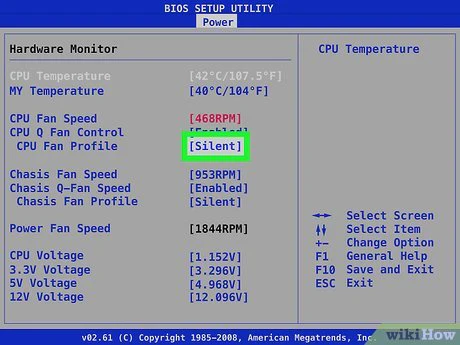Measuring your CPU fan speed is crucial for maintaining the overall health and performance of your computer. The CPU fan plays a significant role in cooling your processor, and incorrect fan speeds can result in overheating, system instability, and potentially, hardware damage. Whether you want to monitor system performance or troubleshoot overheating issues, there are several methods to measure and adjust CPU fan speed.
“To measure your CPU fan’s RPM, access your system’s BIOS or UEFI settings during startup, or use monitoring software like HWMonitor. These tools display real-time fan speeds and temperature data.”
In this article, We will discuss “ how to measure CPU fan”
Table of Contents
Measuring CPU Fan Speed via BIOS/UEFI Settings:

Accessing the BIOS (Basic Input/Output System) or UEFI (Unified Extensible Firmware Interface) is one of the simplest and most reliable ways to measure CPU fan speed. It requires no additional software and provides real-time information directly from your system’s hardware.
Steps:
- Restart your computer.
- As the system restarts, press the key to enter BIOS/UEFI. Common keys include Delete, F2, F10,or Esc. The key varies depending on the manufacturer.
- Once inside BIOS/UEFI, navigate to the “Hardware Monitor” or “Fan Speed Monitor” section. Some systems may label it as “PC Health” or “System Monitoring.”
- Here, you’ll see the CPU fan’s speed in RPM, along with temperature readings for your CPU and motherboard.
- If you want, you can also enable “Fan Control” to adjust fan speeds according to temperature thresholds.
Pros:
- No need to install additional software.
- Provides accurate readings directly from the hardware.
Cons:
- Requires restarting your system.
- Cannot monitor fan speed continuously.
Using CPU Monitoring Software to Measure Fan Speed:
For those who want to monitor their CPU fan speed without restarting the system, using third-party software is a popular option. These programs provide detailed system information, including CPU fan speed, temperatures, and voltage readings, all in real time.
Also Read: Oc Is Not Supported CPU – A Guide For Gamers And Enthusiasts!
Popular Monitoring Tools:
- HWMonitor: One of the most reliable tools for monitoring fan speeds, voltages, and temperatures.
- SpeedFan: Allows users to not only monitor fan speed but also control it manually.
- Open Hardware Monitor: Open-source and lightweight, this tool offers real-time CPU temperature and fan speed readings.
Steps:
- Download and install the software of your choice.
- Launch the software, and it will automatically detect and display your system’s fan speeds, CPU temperatures, and other hardware metrics.
- Some tools, like SpeedFan, also allow you to manually adjust the fan speeds or set custom fan curves for better cooling management.
Pros:
- Provides real-time, continuous monitoring.
- Some tools allow fan speed control.
Cons:
- Requires software installation.
- Not all tools support all motherboard models, so some features may be unavailable.
Using Motherboard Utilities for Fan Monitoring and Control:

Many motherboard manufacturers provide software utilities to monitor and control fan speeds. These utilities are designed to work seamlessly with your motherboard, offering real-time fan speed readings and various customization options to optimize cooling performance.
Popular Motherboard Utilities:
- ASUS AI Suite: for ASUS motherboards.
- MSI Dragon Center: for MSI motherboards.
- Gigabyte EasyTune: for Gigabyte boards.
Steps:
- Download the utility from your motherboard manufacturer’s website.
- Install and launch the program.
- Navigate to the fan control section. This is usually found in the “Cooling” or “Hardware Monitor” tab.
- You’ll see your CPU fan speed displayed in RPM, along with options to adjust fan speed profiles, like “Silent Mode,” “Standard Mode,” or “Turbo Mode.”
- Many utilities allow you to create custom fan curves, where you can set the fan speed based on specific temperature ranges.
Pros:
- Provides full control over fan speeds and profiles.
- Tailored specifically for your motherboard.
Cons:
- Only works with supported motherboards.
- Some utilities may consume more system resources.
Using Fan Controllers to Measure and Control Fan Speed:
For PC enthusiasts who like hands-on control, using a fan controller is another excellent option. Fan controllers allow you to directly monitor and control fan speed through a physical interface, often placed in a front bay of your computer case.
Also Read: Why Is My CPU Overclocking Itself – Common Causes And Solutions!
Steps:
- Install the fan controller inside your PC case.
- Connect the CPU fan to the fan controller using the appropriate cables.
- Once powered on, the fan controller’s display will show real-time RPM readings for the connected fans.
- Use the controller’s buttons or dials to adjust the fan speed according to your preference.
Pros:
- Gives you physical, real-time control over fan speeds.
- Some controllers come with LCD displays for easy monitoring.
Cons:
- Requires hardware installation.
- Not as automated as software-based monitoring.
Using Command Line Tools (For Advanced Users):

On some operating systems like Linux, you can use command-line tools to measure CPU fan speed. This method is ideal for advanced users who prefer using terminal commands.
Steps (Linux Example):
- Open the terminal.
- Install `lm-sensors` by running the command:
bash
sudo apt-get install lm-sensors
- Detect sensors using the command:
bash
sudo sensors-detect
- Finally, display fan speed and other sensor data using:
bash
sensors
Pros:
- Provides detailed and real-time sensor readings.
- Lightweight, with no need for graphical interfaces.
Cons:
- Requires advanced technical knowledge.
- Not as user-friendly as GUI-based tools.
Manually Checking the Fan for RPM Labels:
Though less common, some CPU fans come with labels on the fan body that indicate the rated RPM range. While this method doesn’t provide real-time measurements, it can give you a general idea of your fan’s speed capabilities.
Also Read: Lga1150 Socket CPU List – Overview Of Compatible CPUs!
Steps:
- Turn off your computer and unplug it from the power source.
- Open your computer case and locate the CPU fan.
- Look for a sticker or label on the fan’s body, typically located at the center hub. This label may display the rated RPM range, for example, “1200-2000 RPM.”
- Use this information to estimate the fan speed, though it won’t be an exact real-time measure.
Pros:
- No software or hardware is needed.
- Provides a rough idea of fan speed.
Cons:
- Does not provide real-time monitoring.
- Not all fans have RPM labels.
Why CPU Fan Speed Matters:
Monitoring your CPU fan speed is essential for several reasons:
- Preventing Overheating: If your CPU fan isn’t spinning fast enough to cool your processor, it could lead to overheating, thermal throttling, and potential hardware damage.
- Noise Control: Sometimes, fans may run too fast unnecessarily, leading to excessive noise. By measuring and adjusting the fan speed, you can reduce noise levels.
- Extending Component Lifespan: Proper cooling ensures your components run at optimal temperatures, prolonging their lifespan.
- Energy Efficiency: Regulating fan speeds can help reduce power consumption, especially for systems running on battery or lower power sources.
FAQ’s
1. How do I check CPU fan speed in BIOS?
You can check CPU fan speed in BIOS by restarting your computer and pressing the designated key (usually F2 or Delete) to enter BIOS. Navigate to the “Hardware Monitor” or “Fan Speed” section to view the RPM.
2. Can I monitor CPU fan speed in Windows?
Yes, you can use third-party software like HWMonitor, SpeedFan, or Open Hardware Monitor to check CPU fan speed on Windows in real-time.
3. Can I adjust CPU fan speed manually?
Yes, you can adjust CPU fan speed using software tools like SpeedFan or motherboard utilities such as ASUS AI Suite, MSI Dragon Center, or a fan controller.
4. What’s the ideal CPU fan speed?
The ideal CPU fan speed varies by the fan and CPU model but is usually between 1000-2000 RPM under normal conditions. Higher speeds may be necessary during heavy workloads.
5. Do I need to install extra software to measure CPU fan speed?
No, you can check fan speed via BIOS without installing additional software, but tools like HWMonitor offer more real-time monitoring and control options.
Conclusion
Measuring CPU fan speed is essential for maintaining optimal system performance and preventing overheating. You can easily check fan speed through BIOS, third-party monitoring software, or motherboard utilities, with each method offering varying levels of control. Regularly monitoring fan speed helps ensure your system runs efficiently and quietly.

